It has been quite the hiatus since we last touched on the topic of ancient Aandhra capitals. Following Amaravati and Warangal, we proceed with our Continuing Series on Telugu Cities, their Art, & their Architecture with Srikakulam.
Background
The City of Srikakulam (Sreekaakulam) is steeped in both story and history. Within a few kilometres of the modern city are a number of ancient Hindu and Buddhist landmarks. Sri Koormam, Sri Mukhalingam, and Salihundam are all standout sites that not only dot the landscape, but also imbue the history of this, the first capital of the Aandhras, fittingly in Uttarandhra.
Location
Located in Srikakulam District, the urban agglomeration of Srikakulam is at a pivotal point in the region. It is a stone’s throw away from Odisha, thereby making it the traditional capital of Kalingandhra. Indeed, Kalingapattanam (the old Port of Kalinga desa) is located within that district’s boundaries.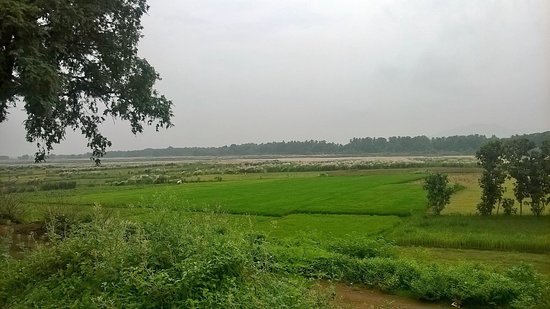 The landscape of Srikakulam is known for Uttarandhra’s celebrated greenery. It needs no introduction.
The landscape of Srikakulam is known for Uttarandhra’s celebrated greenery. It needs no introduction.
“Srikakulam District is the extreme Northeastern District of Andhra Pradesh situated within the Geographic Co-Ordinates of 18°-20’ and 19°- 10’ of Northern latitude and 83°-50’ and 84°-50’ of Eastern longitude. The Nagavali, Vamsadhara, Suvarnamukhi, Vegavathi, Mahendratanaya, Gomukhi, Champavathi, Bahuda and Kumbikota Gedda are the important rivers of the District . The Vamsadhara river rises in the Eastern Ghats of Orissa State and enters Srikakulam District in Bhamini Mandal and finally falls into the Bay of Bengal near Kalingapatnam.” [6]
History
The History of Srikakulam begins with the Temple of Srikurmam.
“Srikurmam Shrine, as per Puranas, is encircled by Pancha Linga Kshetras (5 Shiva Temples) and Ashta (8) Tirthas spread over a distance of about 30 KiloMetres. This Triangular area between theTwo rivers & Sea – Nagavali , Vamsadhara and the Bay of Bengal is praised to be the Kali Yuga’s Vaikuntham. It is said that Bala Rama (Elder brother of Sri Krishna), when he visited the Shrine during his Southern Pilgrimage, ordained that Srikurmam be the only Kurma Kshetra in the World and that no imitations be built for Kurmanadha anywhere else. He dug the earth and made a river to flow. This river is called “Nagavali” and flows around the Western periphery of Srikurmam Shrine alongwith the River “Vamsadhara” flowing on the Northern Periphery.” [1]
Being designated as the only site to feature the Tortoise, or Koorma Avathaara, of Lord Vishnu gives this site a unique and legendary status. Many would naturally date it in yugas rather than mere millennia or centuries.
However, this is not the only prominent Hindu temple in the vicinity.
“The Shiva Temple on the western periphery of Srikurmam Shrine is – Sri Uma Rudra Koteswara Temple on the banks of Nagavali river in Srikakulam Town (about 12 km from the main Srikurmam Temple). The Temple on the eastern border of Srikurmam Shrine is located at kalinga patnam (about 15 km from the main Srikurmam Temple).Similarly, the Northern & Southern border Temples of Shiva are located at Singupuram and Ippili Villages.The fifth Shiva Temple is located adjacent to the main Temple complex of Sri Kurmanadha.” [1]
There is also the famous and ancient Srimukhalingam.
Srimukhalingam
Approximately 56 km away from the town of Srikakulam is Srimukhalingam. This site is said to be the ancient capital of Kalinganagara (after Dantapuri/Dhanthapura). It features not one, not two, but three key temples within the complex of Srimukhalingam. It is the delight of saivites.
Not to be left out, Bauddha Dharma also once featured prominently here. The site of Salihundam remains an archaeologist’s delight to this day.
Salihundam
Once the location of a lovely Buddhist Sthupa, Salihundam preserves the remains of this sacred site to Bhikkhus.
It features a number of stupas and monasteries, and includes some votive sites as well.
Sreekaakulam
The city of Srikakulam was famous in ancient days as the first capital of the Aandhras. Indeed, the story of the Aandhras is traced to Andhra Nripathi who is said to have led his people from the Eastern province of Prachyam through Eastern Ghats, into what is now Kalingaandhra (Uttarandhra). Though this region is a crossroads of culture today (both Telugu & Odia), it nevertheless has a hallowed history as a city of Aandhra Kings.
“According to the story recorded in the Brhatkathaa, Deepakarni, the king of Sreekakulam found a prince riding on the back of a lion (Simhadhara) and adopted him as his son. The boy became Saatavaahana, Saata being the name of the lion, and became the founder of the Saatavaahana dynasty.” [2,77]
This is corroborated by the later history of the Satavahanas. “As the Satavahana empire carried on brisk trade with foreign countries a number of cities like Prathisthana, Sopara, Nashik, Govardhana, Tagara Kanheri, Kalyana, Vaijayanti, Amaravati, Vijayapuri, Srikakulam, developed in different parts of the empire. The affairs of these cities were looked after by corporate bodies called Nigama Sabhas which had a representative character.” [2, 16]
The importance of this Srikakulam (as opposed to Srikakulam village in Ghantasala), is further underscored by Xuan Zhang. “From the travel record of the pilgrim we get a picture of Andhra in the first half of the 7th century A.D. Hiuen Tsang entered Srikakulam district which then formed part of the Kalinga kingdom.” [2, 39]
Having established the religio-cultural antecedents to Srikakulam, one can now delve into the material history of the city itself. The story of the city of Srikakulam begins with the Kalingas.
Kalingandhra
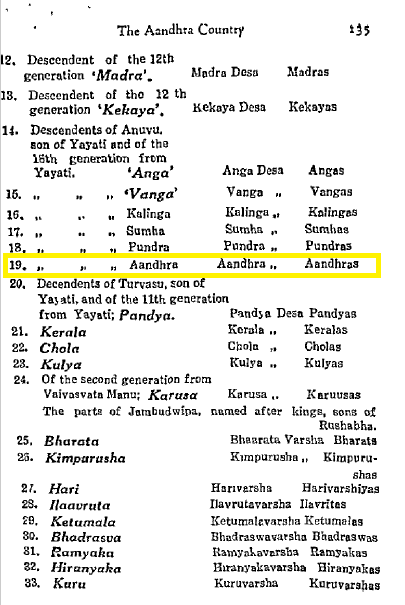
It is said that the Kalingas and Aandhras were once one. Both originating in the line of Bali, son of Yayaathi of the Chandravamsa, Kalinga & Aandhra were granted the lands to the South, and ruled as the first kings of these desas. Because they took the eastern coastal route, it is natural that Srikakulam would be the first capital of the Andhras.
Today all sorts of political motivated theories have been developed to claim the origins of the Satavahanas, but Pauranic evidence is quite clear that though Satavahana was born in Pratishthaana (Paithan), his father was king of Srikakulam—and ergo, an Aandhra.
Why were the regions of Asmaka and Aandhra linked?—well, see for yourself.
At varying points, the Aandhras ruled lands throughout India, even in Maharashtra. For this reason there has been some confusion (some of it purposeful) resulting in an attempt to deny the Aandhra origins of the Satavahanas. But the Puraanas and the oral history of the Aandhras are quite trenchant in establishing that the Satavahanas were Aandhras , and Srikakulam was their first capital.
It is also no accident that the fate of Srikakulam would be joined with the ancient city of Kalingapatnam. Pattana (in Sanskrit) means port-town. The Kalingas were accomplished mariners and Odias to this day have a number of beautiful festivals and traditions based around this history (i.e. Bali Jatra & toy boats). Srikakulam town is a mere stone’s throw away at approximately 10km, and 56 km from Kalinganagara (Srimukhalingam).
Art
Srikoormam
The temple of Srikoormam features not only traditional temple sculptures, but also painted murals of comparatively recent origin. Telling the tale of the shrine and the avatar behind it, it is the apple to the eye of the yaathri. They bring to one’s mind Lepakshi itself.

Srimukhalingam
The Art of Srimukhalingam, like most of the region, is primarily sculptural. In stone, it stood the test of time and told its stories over centuries.
The themes are Saivite in nature, and frankly dabble in the tantric. Themes and motifs such as the khatvaanga are indicative of the particular style of rituals that were (and are?) in fashion here. Certainly food for thought for those of us of a more sattvic disposition, and perhaps an explanation for the past millennium…
Indeed, in this area, tantra touched not only the saivite but also the buddhist. As mentioned above, vajrayana was en vogue here not too long ago.
Salihundam

Despite the massive size of this area, it remains somewhat under-maintained. Many precious sculptures face degradation. Nevertheless, the Buddhist iconography remains visible to this day.
#BuddhisminAndhraPradesh #Salihundam is a tiny village situated on the banks of d #Vamsadhara River in #Srikakulam Dist #APTDC #aptourism pic.twitter.com/KDQqZvyR4P
— AndhraPradeshTourism (@APTDCofficial) June 19, 2017
Architecture
The architecture of the district is often called “Indo-Aryan” style, which is somewhat limiting and over-general at the same time. Specifically, there is no one “Indo-Aryan” style, but a number of Saastriya styles, as well as Buddhist, etc styles. As for the temple architecture, it is best monikered as Kalinga Nagara Style. It is clearly distinct to the Kalinga-Odhra region, and is anchored in the Nagara reethi that is popular in Northern India.
Arasavalli
Much like today, there are many royal claimants to descent from the Sun, and for that reason, it is only natural that worship of the Solar deity be prominent in such areas. Srikakulam’s Arasavalli is one such example.
“The famous Sun God Temple situated in Arasavalli Village which is at a distance of about 1 K.M. east of SRIKAKULAM Town in Andhra Pradesh head quarters of the coastal district in Andhra Pradesh . It is one of the ancient and all among two sun God temples in our Country. According to Padmapuranam , Sage Kasyapa installed the Idol of Surya at Arasavalli for the Welfare of mankind . ” [6]
Whatever the antiquity of the site, fresh coats of paint have brought out an eye-catching bouquet of colours in the verdant landscape.
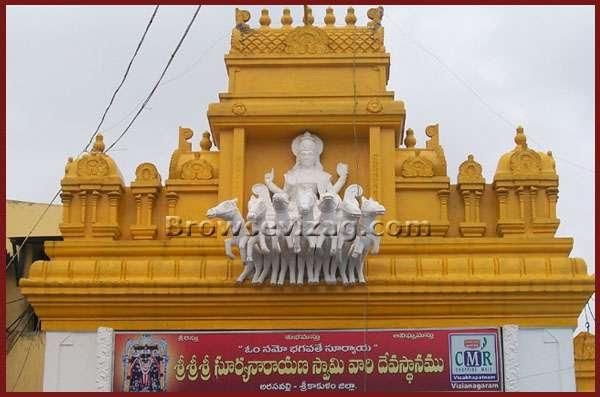 The magnificently painted white temple is a contrast to the earthy tones of the other architectural sites. Surya deva is suitably worshipped here, for the benefit of all mankind.
The magnificently painted white temple is a contrast to the earthy tones of the other architectural sites. Surya deva is suitably worshipped here, for the benefit of all mankind.

Srikurmam
Practically at the edge of Srikakulam, the temple town of Srikoormam features a charming and ancient devayathana.
The temple of Srikoormam Svayambhu Vishnu features gopuras in the traditionally dubbed dravida style. While the shrine itself is dated in yugas, the main gopuram is considered to be about 2000 years old.
Srimukhalingam
“Srimukhalingeswara Temple is a temple dedicated to Lord Shiva located on the left banks of River Vamsadhara. Elegantly carved, this temple is a group of three temples dedicated to three forms of Lord Shiva namely, Mukhalingeswara, Bhimeswara and Someswara.” [6]
The Srimukhalingam temple which was also known as Kalinganagaram was the capital of the early Eastern Ganga Dynasty. #AndhraPradesh #HinduTemple #Hinduism #SanatanDharma pic.twitter.com/EdsgLsJgjK
— Hinduism Thrives (@HinduismThrives) December 27, 2022
Indeed, this pilgrimage site is not a singular edifice, but a veritable complex for the devotee’s bliss.
Salihundam
Saalihundam is the Odia equivalent to the term Saalikonda, or Hill of Rice. This is appropriate given the view that it was once a Satavahana Granary.
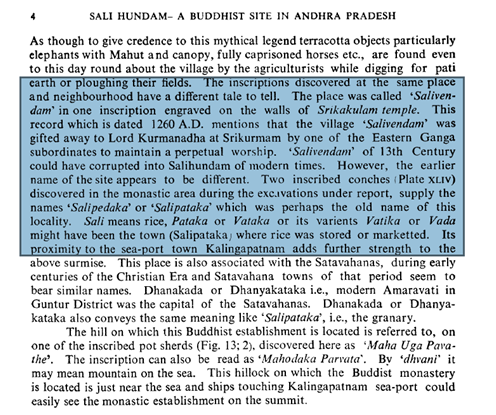
“Salihundam in Srikakulam district is spread over 57 acres extent of land located adjacent to Vamsadhara river and 12 km away from the National Highway-16. Here Buddhist remains like stupams and chaityam can be seen which have been attracting tourists from far and near.” [3]
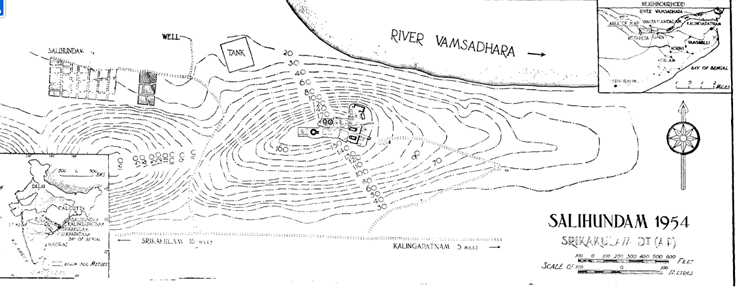
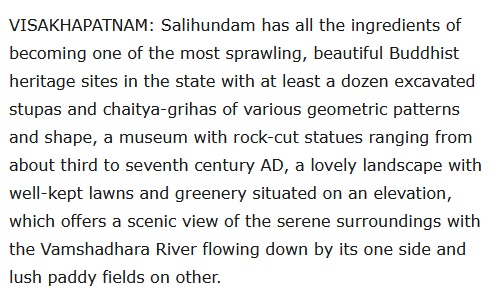
But to amateur archaeologists, the layout of the land is more interesting than the layout of the society. Facts, after all, can’t be forged—or so we’re told!
Layout

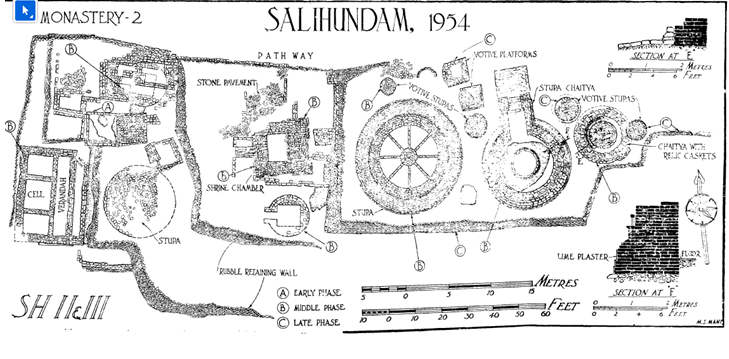
Salihundam alone could consist of another article, so what of the rest of Srikakulam itself?
salihundam in srikakulam pic.twitter.com/4qPvwTqxMx
— rama krishna vysyaraju (@RamaVysyar9342) April 6, 2023
Kalingapatnam
Srikakulam’s relevance would return when the Gangas switched their capital from Dhanthapura to Kalinganagara, near Mukhalingam.
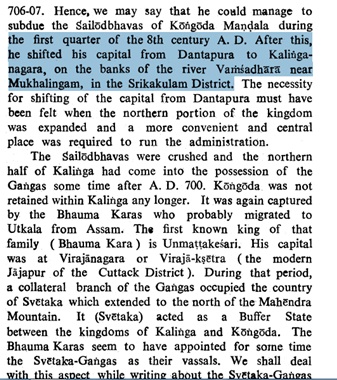 The first record of Srikakulam is found in the copper plates.
The first record of Srikakulam is found in the copper plates.
However, the fates of cities and regions so often revolve around their forts rather than their temples. Srikakulam proved no different.
Fort
The fort proper at Srikakulam likely dates back to the Reddi kings, who were prominent fort-builders. Following the rule of the Kakatiyas, the Eastern Gangas, and the Reddi Dynasty, Srikakulam would experience the churn between the Gajapathis of Odisha and the Emperors of Vijayanagara.
Srikakulam also featured prominently in the later medieval and colonial history of the region. The fort’s strategic position at the bridgehead of a river afforded control of the immediate vicinity to a number of foreign rulers.
From 1571-1758, Srikakulam would be under turkic rulers. From 1753-1759, it was under French administration, though under official rule of Hyderabad. The French would be defeated and ejected by the Telugu King Pusapati Sitarama Raju. This was the period of the Bobbili Yuddham and its aftermath, with Vizianagaram rising to prominence through its politicking between the nizam, the french, and the british. It is appears the kingdom was playing a tripartite game between the three powers, by playing them against each other. It very nearly succeeded before the British defeated them at the Battle of Padmanabham, demoting the princely state to the Estate of Vizianagaram.
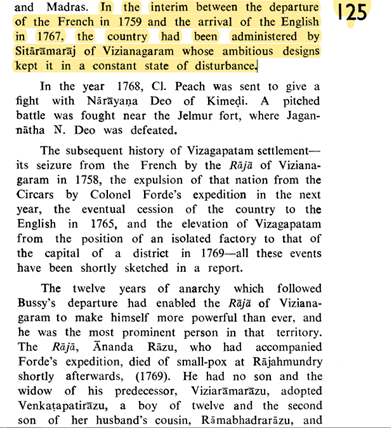 350 years is obviously a drop in the water in the almost 3000 year known history of Kalinganagaram/Srimukhalingam. Nevertheless, understanding such periods of foreign occupation also facilitate a better understanding of the nature of one’s culture and identity. More pertinently, it is about understanding that the city of Srikakulam has an ancient history and legacy beyond the neophyte/neologism known as “Chicacole”.
350 years is obviously a drop in the water in the almost 3000 year known history of Kalinganagaram/Srimukhalingam. Nevertheless, understanding such periods of foreign occupation also facilitate a better understanding of the nature of one’s culture and identity. More pertinently, it is about understanding that the city of Srikakulam has an ancient history and legacy beyond the neophyte/neologism known as “Chicacole”.
Conclusion
Recently, colonial and neo-colonial invaders have made it a point to persianise everything from forts, to handicrafts, to city names themselves. Chicacole (now dubbed “Gulshanabad”) is one such example. But Hyderabad will always be remembered as a mere extension of Golkonda, and Srikakulam will always be associated with Srikurmam. Ironically, both are ~10 km from their main towns (the size of most large cities). Even Srikakulam’s material history begins with the Kalingas, bearing concrete evidence with the Ganga dynasty. By fighting silly caste and linguistic wars, Bhaaratheeyas ignore the wider colonial wars being imposed upon them one-sidedly.
Understanding the history of a desa (country) or pradesa (province) involves setting aside chauvinism and understanding truth. In the ‘crusade’ to justify political realities such as Telangana, many ritualist-materialists are concocting fake histories and appropriating that of others (specifically, Maharashtra’s). As previously discussed, Asmaka mahajanapaadha was concentrated around the headwaters of the Godavari, at Nashik. This is deep in Maharashtra and it is silly for patwari wazirs attempting to justify their misrule and exploitation of the innocent Telugu masses of Telangana. As an actual Telugu Pandit Kota Venkatachalam gaaru, wrote, Aandhram = Telugu. It was the Sanskrit name for our beloved mother tongue, and naturally, the ancient desa of Telugus was not Asmaka, but rather, was Aandhra desa.
However, the problem for old AP state was not linguistic states as a concept; it was that it was over-grand in its dreams of uniting absolutely all Telugu speakers. Those who wish to have their rights respected must learn to respect the rights of others. Meaning: the reason why AP always seemed to burst at the seams was not just due to Telangana, but the fact that portions of it were historically part of other desas.
Rayalaseema was part of Aandhra desa, but portions of its border districts were historically part of Karu desa (and that would mean breaking Karnataka). Portions of Nellore and Chittoor districts were in fact part of Chola desa (but that would mean breaking Tamil Nadu). Finally, the northernmost portions of Aandhra, such as Srikakulam were historically part of Kalinga desa (but that would mean breaking Odisha). In fact, at one stage, Telugus were attempting to claim upto Ganjam in Odisha and Hampi in Karnataka!
Telangana is in its situation today because portions of its border districts were historically part of Maharashtra (which itself would have to break into Vidarbha, Asmaka, and Laatha desas). So the research and revival of historical identities has to be careful so that it doesn’t re-imagine concrete facts or ignore modern realities and new identity groups. In the ambition for land, many otherwise sensible states lose their ability to think and act coherently and unitedly.
All of this is why Uttarandhra was historically referred to as Kalingandhra. However, Uttarandhra by itself is unviable as a state—so those demanding it would be well-advised to consider the feelings of their Odisha friends (who may not sanction a separate Kalinga Pradesh, with its old capital of Danthapuri). The reality is, linguistic states have served to guard the distinct linguistic cultures of their ancient regions. A Telugu speaker need not live in the Telugu states—but those states should dedicate themselves to preserving the Telugu language (unlike the English medium of today…). Language alone does not make up culture (which explains the adharmic dmk’s antics in Tamil Nadu), but language is the sine qua non of cultural communication.
This is what language parochialists don’t understand. In the quest for caste rivalry (Tamil Nadu) or regional rivalry (Karnataka), they don’t see that while Hindi chauvinists are wrong in their narcissism and uccharana, they are correct that a common native Indian language is required for internal communication—with Hindustani having widespread currency today. Hindi may be spoiling local pronunciation, but English is endangering Telugu in the Telugu states itself…
Whether Uttarandhra remains in Andhra Pradesh or forms a Kalinga Pradesh with Southern Odisha, citizens must start behaving responsibly in determining their demands and their politicians and their political thought. True, India is saddled with terribly corrupt politicians—but rivalry and revdi obsessed prajas are also to blame. You get the government you deserve. As an eminent commentator (now fittingly fallen out of grace…) once said, in a democracy Yatha praja, thatha raaja.
శిథిలావస్థలో శ్రీముఖలింగేశ్వరాలయ శిల్ప సంపద | Srimukhalingam Temple Sculptures in Ruined Situationhttps://t.co/HNPHeBQkhO pic.twitter.com/UBqhBNB3LL
— ETV Andhra Pradesh (@etvandhraprades) December 16, 2023
References:
- Sri Kurmam Temple. https://www.srikurmam.info/about-temple
- Sitaramamma, J. Mahayana Buddhism in Andhradesa. Delhi: Eastern Book Linkers. 2005
- “Salihundam gets ASI recognition”. The Hans India. https://www.thehansindia.com/amp/andhra-pradesh/salihundam-gets-asi-recognition-547750
- “Salihundam Buddhist heritage site, museum need attention” . Times of India. https://timesofindia.indiatimes.com/city/visakhapatnam/salihundam-buddhist-heritage-site-museum-need-attention/articleshow/54899417.cms
- Salihundam.
- “Religious Tourism”. Srikakulam District. https://srikakulam.ap.gov.in/religious-tourism/
- Law, Bimala Churn. Historical Geography of Ancient India. Delhi: Ess Publ. 1996
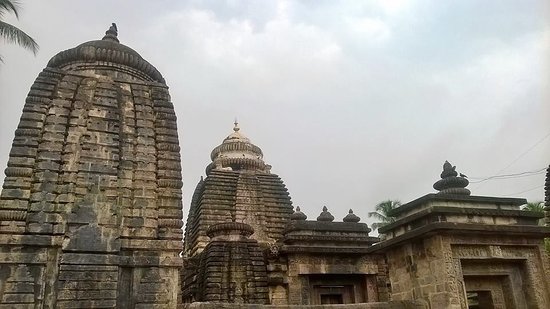
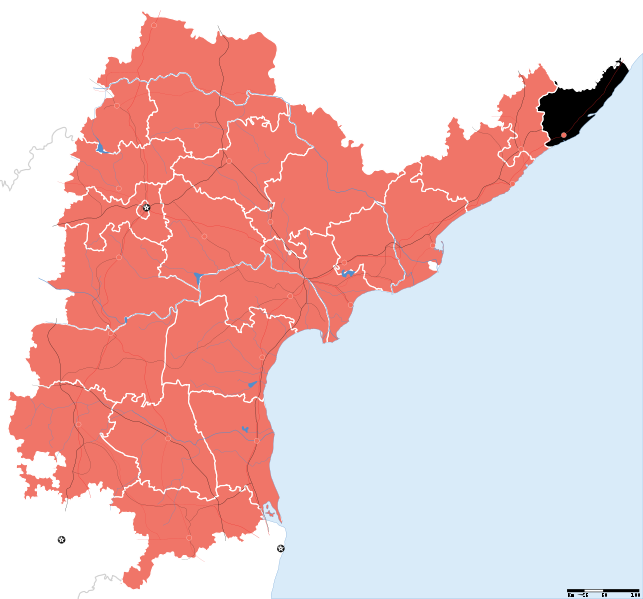
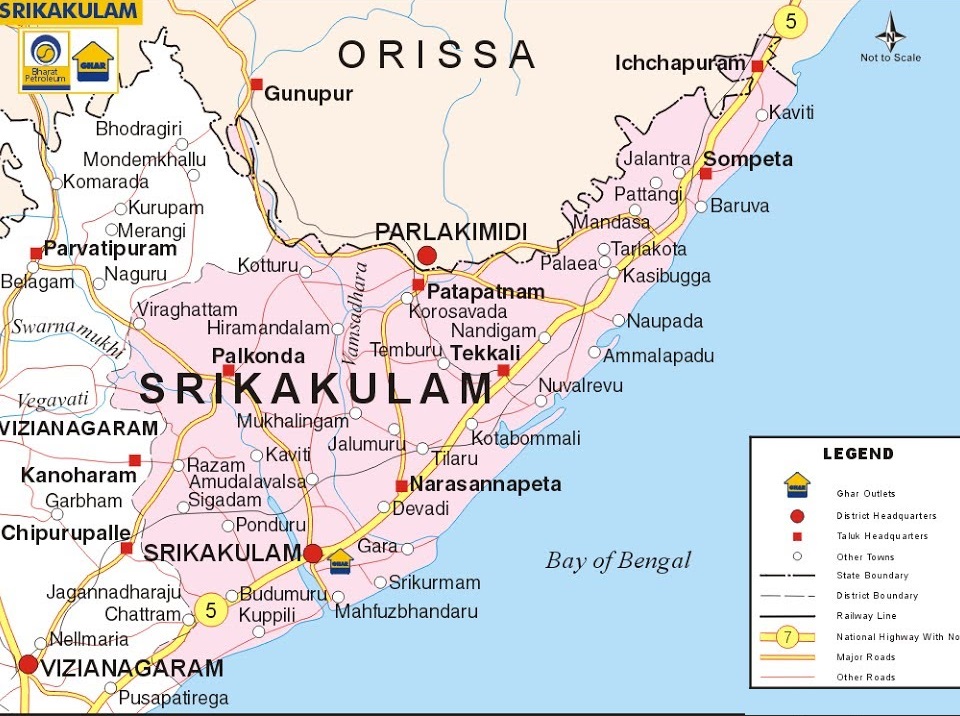

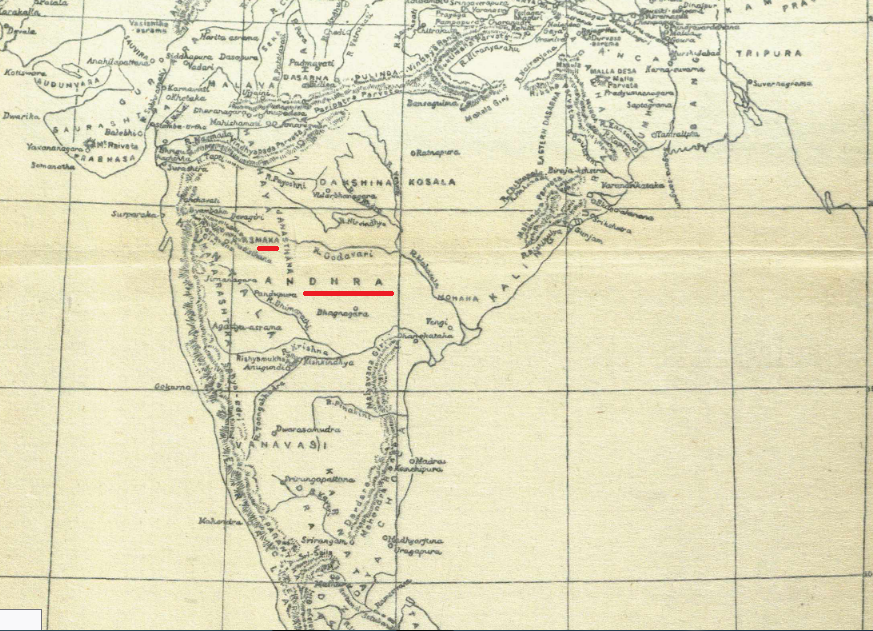


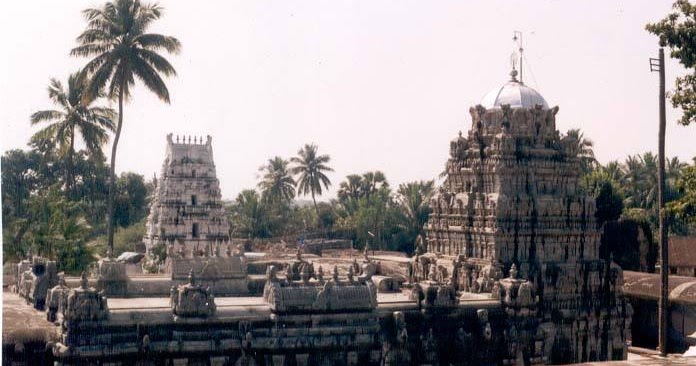
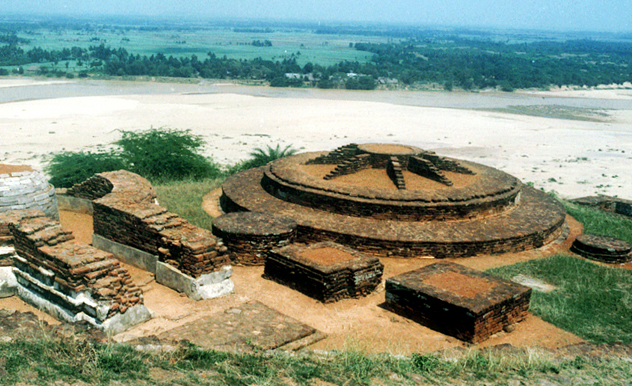
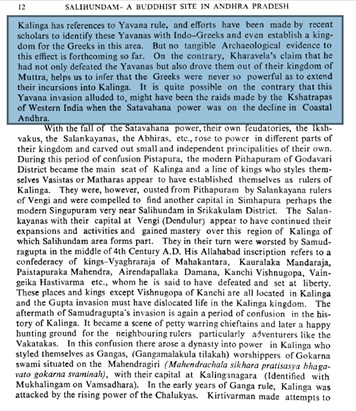

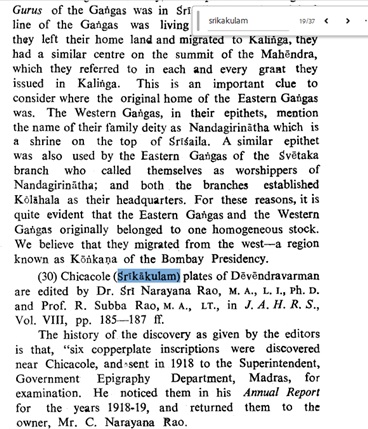



![[Reprint Post] Bharat Ratna: NTR & Self-Respect](http://andhraportal.org/wp-content/uploads/2016/10/ntr_movies_list-150x150.jpg)


